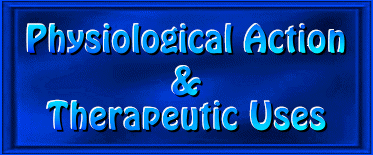

The following is excerpted from The Professional's Herbal Formula Handbook No. 11, comprising 82 pages of traditional information and recent scientific data that describes the medical properties, physiological action and therapeutic uses for each of the 24 ingredients outlined in this formula.




Adaptogenic, alterative, anabolic, anti-aggregant antibiotic, anti-cachexic, anti-dyscratic, anti-infective, antioxidant, antiphlogistic (anti-inflammatory), antiseptic, bacteriostatic (anti-bacterial), cytophylactic, cytotoxic, disinfectant, immuno-potentiating, immuno-stimulant, microbicidal (anti-microbial), rejuvenative, relaxant, restorative, stimulant (circulatory and secretolytic), tonic and vasodilator.


Alleviates any general fluids dyscrasia
(abnormal or pathological condition) within the arteries, blood
vessels or capillaries throughout the circulatory system that
leads to the onset of various degenerative or debilitative
conditions associated with any blood disorders or blood
impurities involving the presence or persistence of various
pathogenic bacteria or microorganisms and their toxins in the
blood (sepsis) or the retention of excessive by-products of
protein metabolism in the blood that leads to various toxic
conditions (uremia), and eliminates any form of cachexia (state
of malnourishment and general debility) within the arterial,
venous or capillary system while removing any chronic fatigue or
exhaustion associated with excessive accumulations of toxic waste
materials throughout the bloodstream and tissue-systems; exhibits
cytophylactic and cytotoxic activity in order to provide stronger
cellular defense mechanisms against many physical or chemical
agents, and displays anti-infective and disinfectant properties
in order to promote increased resistance by destroying any
invasive or harmful pathogenic bacteria, microbes or viruses that
are often responsible for various infectious states or
inflammatory conditions; exhibits bacteriostatic and microbicidal
activity in order to strengthen and increase the resistance of
the arteries, blood vessels and capillaries against any invasive
or harmful bacteria or microbes, as well as to inhibit the
further development of any infectious or inflammatory conditions
associated with the onset of sepsis, septicemia or uremia;
demonstrates significant antiphlogistic effects in order to
inhibit the formation of certain inflammatory compounds (such as
histamine, leukotrienes, prostaglandin, serine proteases and
thromboxanes), as well as to reduce any severe inflammatory
swelling associated with sepsis, septicemia or uremia by exerting
an extremely positive influence towards correcting any internal
inflammatory conditions within the arteries, blood vessels or
capillaries; exhibits significant antiseptic activity by
destroying the vitality of any organized living ferments in order
to prevent the onset of putrefaction or septicemia (including
puerperal), and precipitates the proteins in any inflamed tissues
in order to provide a mildly antiseptic and protective coating
(under which the regeneration of new tissue occurs) for the
arteries, blood vessels and capillaries throughout the entire
organism; acts as an effective antiseptic in order to remove any
septic conditions associated with tissue degeneration or
ulceration, and promotes increased suppuration and a steady
toning or restorative impression to the entire glandular system
(especially the liver, spleen and lymph glands); relieves any
cerebral vascular insufficiency (geriatric dementia) by
increasing cerebral perfusion (proper infiltration of blood
through the brain tissues), and eliminates any diminished
intellectual capacity or alertness associated with circulatory
insufficiency; displays significant regression of the major
symptoms associated with cerebral vascular insufficiency and
impaired cerebral performance, including short-term memory loss,
vertigo, headache, tinnitis (ringing in the ears), lack of
vigilance ("get up and go") and depression; promotes
more balanced activity upon the arterial and venous systems by
exerting greater tonifying effects that are capable of restoring
increased circulation (in cases of vasomotor paralysis), as well
as relaxant effects upon the arteries and arterioles (in cases of
vasomotor spasms) in those conditions involving cerebral
insufficiency; improves the quality and quantity of the
microcirculation, thereby increasing blood circulation to all the
vital tissues and organs (such as the heart and brain);
re-establishes effective tissue perfusion by increasing the
perfusion rate to various areas of the vascular system (e.g.,
arterial, arteriolar, microcirculatory, venular and venous
components), and enhances greater cellular energy production by
beneficially affecting the various intracellular components; acts
as a restorative to the blood circulation, and strengthens the
entire cardiovascular system by increasing arterial tone,
retarding blood cell "clumping", and reducing any
inflammation in the walls of the blood vessels; regulates both
capillary and venous blood flows to the brain and outer
extremities, and provides increased protection against any damage
to the walls of the blood vessels; increases the tonicity of
those capillaries that transport blood directly to the brain
tissues, and provides greater tonicity to the vein that is
essential to the dynamic elimination of various toxic metabolites
that accumulate during lowered oxygen levels; eliminates any
peripheral arteriopathy (arterial insufficiency of the lower
limbs) and other peripheral disorders, including Raynaud's
syndrome (a vasospastic disorder characterized by pallor and
cyanosis of the fingers), acrocyanosis, postphlebitis syndrome,
obliterative arterial disease (vascular disorder of the lower
extremities), and diabetic peripheral vascular disease; prevents
any peripheral arterial insufficiency or peripheral arteriopathy
(lack of adequate blood supply to the extremities), thereby
reducing any cramping or numbness throughout the extremities;
alleviates any intermittent claudications (painful leg cramps)
associated with arterial insufficiency (reduction of blood flow
to a specific area) that leads to hypoxia (oxygenation
deficiencies), which increases the production of toxic
metabolites and cellular free radicals; provides prophylactic
protection against transient ischemic attacks (by increasing
cerebral blood flow), and prevents the formation of any metabolic
or neuronal disturbances associated with hypoxia by enhancing the
utilization of oxygen and increasing the cellular absorption of
glucose (thereby restoring aerobic glycolysis); inhibits any
systemic organ damage from potentially dangerous chemicals (free
radicals), and acts as a powerful antioxidant for the
neutralization and removal of any excess free radicals throughout
the entire organism; exhibits significant vascular activity
primarily by directly affecting those cells that line the blood
vessels, and secondarily by enhancing the tonicity of the smooth
muscle cells in the blood vessels; inhibits the release of
certain enzymes in such a manner that leads to greater relaxation
of the smooth muscle cells in the walls of the blood vessels, and
improves both blood and plasma viscosity; acts as an inflammatory
autacoid in order to mediate any local tissue response (such as
blood coagulation), and normalizes the blood circulation in those
areas (namely, the hippocampus and striatum) that are primarily
affected by microembolization (small deposits of blood clots);
displays vasodilator effects by stimulating the release of
endogenous relaxing factors (such as endothelium-derived relaxing
factor [EDRF] and prostacyclin) directly into the arterial
endothelium; stimulates the synthesis of prostacyclin, which is
the natural anti-aggretory prostaglandin that is synthesized by
the vascular endothelium (the cells that line the inside of the
blood vessels); displays direct effects upon endothelial cells,
which enhance greater blood flow to the penile arteries and veins
without any alteration in systemic blood pressure; possesses
certain compounds (terpenes) that inhibit the platelet activating
factor (PAF-acether) from activating various immune cells
(neutrophils, eosinophils, macrophages and other phospholipids)
and endothelial cells, which can over-stimulate the immune system
and lead to conditions involving toxic shock from bacterial
sepsis (poisoning); displays potent inhibitory effects against
the platelet activating factor (known as ginkgolide B>A>C)
by competing with PAF-acether for binding (receptor) sites, and
significantly reduces any platelet aggregation, adhesion and
degranulation (caused by direct membranal and antioxidant
effects, the increased synthesis of prostacyclin, inhibition of
the enzyme phosphodiesterase, and the antagonism of the platelet
activating factor) by stabilizing the platelet's membranes and
scavenging any damaging free radicals; exhibits
immuno-potentiating and immuno-stimulatory effects in order to
enhance greater long-term immune potential and overall
non-specific systemic immunity (or immune cell activity) and
increased immune response (by activating the body's natural
defense mechanisms), particularly in relation to the repair and
restoration of any damaged or congested arteries, blood vessels
or capillaries throughout the circulatory system; exhibits
anabolic activity in order to accelerate the production of DNA
and RNA (which enhances the production of proteins in the form of
antibodies), while increasing protein and lipid synthesis in the
bone marrow and DNA/RNA content in the adrenals and lymph nodes
(along with increased body weight and enhanced re-synthesis of
glycogen and high-energy phosphate compounds); demonstrates
powerful adaptogenic (balancing and strengthening) properties in
order to increase the overall resistance of an organism towards
any adverse influences or stressful conditions (whether they be
physical, chemical or biological in nature), especially
throughout the arteries, blood vessels, capillaries and the
entire circulatory system; acts as a secretolytic stimulant in
order to promote increased gastric, pancreatic or intestinal
secretory and motor activity, and enhances greater peripheral
circulation (due to its antioxidant activity); exhibits
significant antioxidant effects in order to provide greater
oxygen-transport capabilities throughout the bloodstream, as well
as enhance the transport of additional oxygen directly into the
cells and tissue-systems throughout the arteries, blood vessels,
capillaries and the entire circulatory system; acts as a
circulatory stimulant by increasing the blood flows throughout
the circulatory system in order to enhance greater nutrient
transport, absorption and utilization, thereby accelerating the
healing processes associated with the repair of any damaged
arteries, blood vessels or capillaries throughout the entire
organism; demonstrates significant rejuvenative and restorative
properties upon the basic plasma tissue-systems throughout the
entire organism, thereby enhancing the production of vital bodily
fluids while providing greater enrichment through increased
assimilation of the various organic mineral salts; accelerates
the recuperative processes that are essential in order to
overcome any chronic degenerative or debilitative diseases or
illnesses, while facilitating greater recovery response during
convalescence in order to fully regain optimal health and
well-being; balances the chemical composition of the blood, and
improves the overall characteristics and condition of the blood;
enhances the overall cleansing process by dilating the surface
capillaries in order to more effectively remove any toxic debris
or metabolic waste materials through the pores of the skin, and
protects against any tissue or organ damage from certain
environmental toxins (such as herbicides and pesticides);
displays alterative activity in order to correct any disordered
bodily function, thereby activating increased alterations in both
metabolic and tissue functions as a defensive measure against the
onset of acute or chronic disease; exhibits restorative effects
in order to regain increased vigor or vitality and greater
strength, while enhancing normal tissue and metabolic functional
capabilities; demonstrates alterative and restorative properties
in order to re-establish healthy systemic functional
capabilities, as well as to establish greater vascular tone
throughout the entire organism (due to its ability to stimulate
increased secretory flows); exhibits alterative effects in order
to stimulate the anabolic growth processes, thereby enhancing the
repair of any degenerated, deteriorated and debilitated cells or
tissues (while promoting the elimination of any catabolic waste
materials); displays tonifying effects in order to permanently
enhance the overall energy-levels throughout the entire organism,
without adversely affecting the functional capabilities of any
particular organ or system.
![]()
None.
![]()